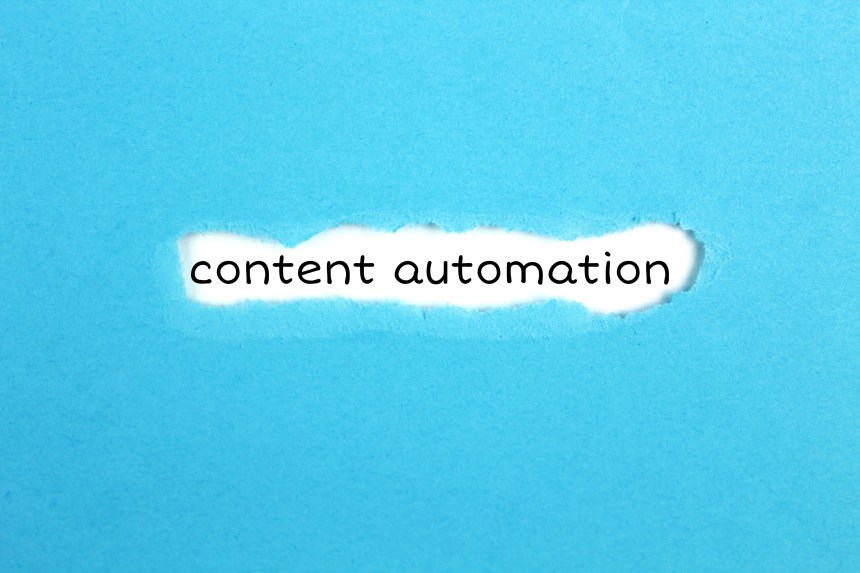In the rapidly evolving world of digital marketing, content automation has emerged as a powerful tool for businesses to optimize their content creation and distribution processes. But what exactly is content automation, and how can you leverage its full potential? In this comprehensive guide, we will explore the ins and outs of content automation, unravel its benefits, and provide actionable insights on how to make the most of it.
Content automation offers immense value, from streamlining repetitive tasks to ensuring consistency across multiple channels. Whether you’re a marketer, entrepreneur, or content creator, understanding the fundamentals of the content lifecycle and implementing effective strategies can significantly enhance your productivity and overall marketing success. Join us as we dive into content automation and uncover the secrets to unlocking its potential.
What is Content Automation?
Content automation refers to using technology and software solutions to streamline and automate various content creation and distribution aspects. It involves leveraging tools, algorithms, and workflows to automate content creation, reduce manual efforts, increase efficiency, and improve overall productivity. Content automation encompasses a range of tasks, including content ideation, creation, editing, scheduling, and publishing.
Following are some of the benefits that come with a content automation process.
Time and Resource Savings
Content automation offers significant time and resource savings by streamlining repetitive tasks. Automating content creation, editing, and distribution processes frees up valuable resources and allows content creators to focus on strategic activities. This leads to increased productivity and efficient allocation of resources. Additionally, a content automation software can help businesses optimize their workflows, reducing manual effort and minimizing the risk of errors or inconsistencies.
Enhanced Consistency and Branding
Content automation, powered by natural language processing ensures consistent messaging and branding across various channels. By automating content distribution, businesses can maintain a cohesive brand image and tone, providing a seamless experience for their audience. Automation tools can apply predefined brand guidelines, ensuring all content aligns with the company’s visual identity, language, and values. Consistent branding builds trust and recognition among the audience, ultimately strengthening the brand’s reputation and increasing customer loyalty.
Scalability and Increased Content Volume
With content automation, organizations can handle larger volumes of content production without compromising quality. Automation tools enable the creation of scalable workflows, making managing content across multiple platforms and reaching a broader audience easier.
Whether creating blog posts, social media posts, updates, or email campaigns, automation streamlines the process, allowing businesses to produce content at scale within the same timeframe. This scalability is particularly valuable for growing businesses or those aiming to expand their content marketing efforts. Companies can maintain a consistent content presence across various channels and cater to a larger audience by automating tasks like content scheduling, publishing, and distribution.
Improved Personalization and Targeting
Content automation allows for better personalization and targeted content delivery. Businesses can collect and analyze data by leveraging automation tools to understand their audience’s preferences, behaviors, and demographics. This data-driven approach enables the creation of personalized content tailored to specific segments or even individual customers.
Automation tools can automate segmenting the audience and delivering the right content to the right people at the right time. This level of personalization enhances user experience, increases engagement, and improves conversion rates. Businesses can build stronger relationships with their audience and drive meaningful interactions by delivering relevant content based on user preferences.
Ready to revolutionize your content creation with the power of automation?
Contact Growth Hackers
Streamlined Collaboration and Workflow
Content automation facilitates streamlined collaboration and workflow among teams. Automation tools provide a centralized platform where content creators, editors, sales and marketing teams, and other stakeholders can seamlessly collaborate, review, and approve content. Workflow automation ensures that everyone involved in content creation is informed about their tasks and deadlines, reducing bottlenecks and delays.
With automated notifications and task assignments, teams can work more efficiently, improving communication and reducing the likelihood of errors or missed deadlines. Streamlined collaboration saves time and enhances the overall quality of content by facilitating effective feedback loops and ensuring everyone is on the same page.
Data-Driven Insights and Optimization
Content marketing automation also provides businesses with valuable data-driven insights to optimize content strategies. Automation tools can track and analyze various metrics, such as engagement, conversion, and audience behavior. By collecting and analyzing this data, businesses can better understand what types of content resonate with their audience and adjust their strategies accordingly.
Automation tools can generate reports and dashboards that offer insights into content performance, helping businesses identify strengths, weaknesses, and areas for improvement. By leveraging data-driven insights, companies can optimize their content creation, distribution, and engagement strategies, leading to more effective marketing campaigns and better overall results.
Common Misconceptions about Content Automation
Along with the benefits, certain misconceptions come with content automation. Let’s know them.
Eliminates the Need for Human Creativity
One common misconception about content automation is that it replaces human creativity entirely. However, content automation is designed to streamline repetitive tasks and enhance productivity, allowing content creators to focus on more strategic and creative aspects. While automation tools can generate content based on predefined templates or data inputs, they do not possess the same level of intuition, emotion, and unique perspective as human creators.
Human creativity remains indispensable for crafting compelling narratives, generating fresh ideas, and understanding the nuances of audience preferences. Content automation complements human creativity by handling repetitive and time-consuming tasks, freeing up valuable time for creators to exercise their creative expertise and deliver innovative and engaging content.
Sacrifices Quality for Efficiency
Another misconception is that content automation compromises the quality of content in favor of efficiency. While it’s true that automation can speed up content production, it doesn’t necessarily mean that quality is compromised. With proper planning and implementation, content automation can ensure consistency and adherence to brand guidelines, resulting in high-quality content.
Automation tools can enforce predefined standards, grammar checks, and quality control measures, minimizing the risk of errors or inconsistencies. It’s important to note that content automation should be complemented by human oversight and quality assurance to maintain the desired level of quality.
Leads to Generic and Impersonal Content
There’s a misconception that automated content is generic and lacks personalization. However, content automation can be highly personalized and targeted when implemented strategically. Automation tools can leverage data and user insights to segment audiences, personalize content recommendations, and deliver tailored experiences.
By analyzing audience behavior, preferences, and demographics, businesses can automate the delivery of personalized content that resonates with specific segments or individual users. It’s important to strike a balance between automation and personalization, ensuring that the content generated by automation tools is adapted and customized to meet the specific needs and interests of the target audience.
Removes the Need for Content Strategy
Some mistakenly believe that content automation replaces the need for a well-defined content strategy. However, content automation should be guided by a robust content strategy that aligns with business goals and audience needs. A solid content strategy sets the foundation for effective content automation by identifying target audience segments, content objectives, and key messaging themes.
Automation tools then support the execution of the content strategy by streamlining processes and facilitating content creation and distribution. The content strategy provides guidance and direction to ensure content automation efforts align with overarching business objectives, maintain brand consistency, and deliver meaningful results.
It is a Set-it-and-Forget-it Solution
A common misconception is that content automation can be set up once and left to run independently. However, content automation requires ongoing monitoring, optimization, and adjustments. Automation tools must be regularly reviewed and refined to align with evolving business needs, industry trends, and audience preferences. Analytics and performance metrics should be continuously monitored to identify opportunities for improvement and fine-tuning.
Additionally, content automation should be flexible enough to adapt to changes in content strategy, emerging platforms, and technological advancements. Regular evaluation and optimization of content automation processes are essential to ensure continued effectiveness and relevance in the ever-changing digital landscape.
How to Make the Most Out of Your Content Automation Process
Let’s dive into how you can make the most out of your content automation process.
Define Clear Objectives and Goals
Before implementing content automation, defining clear objectives and goals is essential. Determine what you aim to achieve through automation, whether it’s increasing content production, improving efficiency, enhancing personalization, or achieving specific marketing outcomes. With specific goals in mind, you can tailor your content automation strategy accordingly and measure its success more effectively. Clear objectives provide a roadmap for implementing automation tools and workflows that align with your business priorities and desired outcomes. They also help align your team’s efforts and ensure everyone is working towards a common goal.
Identify Repetitive and Time-Consuming Tasks
Analyze your content creation and distribution processes to identify repetitive and time-consuming tasks that can benefit from automation. Look for tasks such as content formatting, scheduling, distribution, or social media posting that can be automated.
By automating these repetitive tasks, you can save time and free up resources for more strategic activities that require human intervention and creativity. Identifying the right tasks for automation ensures that you maximize the efficiency gains and overall effectiveness of your content automation efforts. It also allows your team members to focus on high-value activities requiring expertise and generating greater impact.
Experience the transformative impact of content automation and propel your brand forward!
Choose the Right Automation Tools
Selecting the right automation tools is crucial for successful content automation implementation. Consider the specific needs of your content strategy and the tasks you want to automate. Research and evaluate different automation tools available in the market, considering factors such as functionality, ease of use, scalability, and integration capabilities with your existing systems. Look for tools that align with your objectives and offer the required features.
Additionally, consider the level of support and training the tool’s vendor provides to ensure a smooth implementation process. Choosing the right automation tools sets the foundation for an efficient and effective content automation system that meets your business needs and helps you achieve your goals.
Create a Content Automation Workflow
Develop a well-defined workflow that outlines the steps and processes involved in your content automation strategy. Map out the content creation, editing, and distribution tasks and define the roles and responsibilities of the team members involved. Clearly define the automation processes and how they integrate with manual intervention.
A well-designed workflow ensures smooth collaboration and minimizes confusion or bottlenecks. Consider using visual workflow tools or project management platforms to streamline the process and keep everyone aligned. Regularly review and refine your workflow to accommodate changes in your content strategy or automation tools, ensuring continuous improvement and efficiency.
Customize and Personalize Automated Content
While automation can streamline content creation, it’s crucial to ensure that your automated content remains personalized and tailored to your target audience. Leverage automation tools to gather and analyze data about your audience’s preferences, behaviors, and demographics. Use this information to create dynamic templates or rules allowing scale personalization.
Customize automated content by incorporating relevant variables or data points to make it more relevant and engaging. Implement A/B testing to measure the effectiveness of personalized content and optimize your automation workflows based on the results. Striking a balance between automation and personalization ensures that your content resonates with your audience and generates maximum impact.
Continuously Monitor and Optimize
Content automation is not a one-time setup; it requires ongoing monitoring and optimization to ensure effectiveness. Regularly review key performance indicators (KPIs) and analytics to measure the impact of your automated content. Track metrics such as engagement rates, conversion rates, and audience behavior to gain insights into what is working and what needs improvement. Use this data to refine your automation processes, adjust templates or rules, and experiment with new strategies.
Continuously test and optimize your automated content to enhance performance, increase efficiency, and achieve better results over time. By staying vigilant and adapting to changing market dynamics, you can make the most out of your content automation efforts and drive meaningful outcomes for your business.
Closing Thoughts About What is Content Automation and How to Make the Most of It
Content automation is a powerful tool that can revolutionize your content creation and distribution process. Leveraging technology and algorithms enables you to streamline repetitive tasks, enhance productivity, and deliver content at scale. Clearly define your objectives and target audience to make the most of content automation. Utilize AI-powered tools to generate high-quality content, optimize it for search engines, and personalize it for individual users. Remember to balance automation and the human touch, ensuring your content maintains its authenticity and resonates with your audience. With careful planning and strategic implementation, content automation can become a valuable asset in your marketing arsenal.
Growth Hackers is an experienced content creation agency helping businesses from all over the world grow. There is no fluff with Growth Hackers. We help entrepreneurs and business owners implement a successful content automation strategy, increase their productivity, generate qualified leads, optimize their conversion rate, gather and analyze data analytics, acquire and retain users and increase sales. We go further than brand awareness and exposure. We make sure that the strategies we implement move the needle so your business grow, strive and succeed. If you too want your business to reach new heights, contact Growth Hackers today so we can discuss about your brand and create a custom growth plan for you. You’re just one click away to skyrocket your business.








